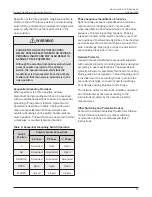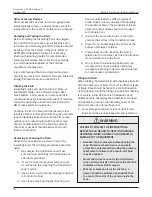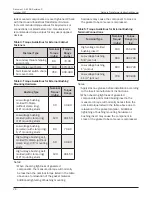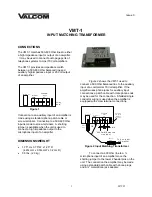
Document 2.4.128, Revision 3
October, 2017
12
Network Transformer Instruction Manual
board located under oil in the transformer
tank. Refer to “
Opening the Transformer
Tank”
for instructions.
4. Tap Changer Setting
For transformers supplied with high-voltage
taps, check the tap changer setting to
ensure it is set to the proper position for the
required voltage. The tap changer setting
must not be changed while the transformer
is energized. Unless otherwise specified,
tapped transformers will be shipped from the
factory with the tap switch set to the nominal
position.
5. Series/Multiple and Delta/Wye Switch
Settings
For transformers supplied with a delta/
wye and/or series/multiple switch, check
switch settings to make sure they are set to
the correct position. If delta/wye or series/
multiple connections are made using an
internal terminal board instead of a switch,
check to ensure that these connections are
made properly according to the chart on the
transformer nameplate. Refer to
“Opening
the Transformer Tank”
for instructions.
Neither the series/multiple nor delta/wye
switch setting should be changed while the
transformer is energized. Unless otherwise
specified, transformers are shipped from the
factory with series/multiple and delta/wye
connections set to the highest voltage.
6.
Grounding
Check to ensure that the transformer tank is
permanently and effectively grounded.
7. Bolted Connections
Check all bolted connections for tightness,
referring to nominal torque guidelines
contained in Tables 3 through 6.
8. Fluid Levels
The transformer main tank and primary
switch chamber are shipped from the factory
with insulating fluid filled to the proper level,
indicated by the 25
°
C mark on the fluid level
gauge. Before energizing the transformer,
verify proper fluid levels by observing the
gauges. Be aware that fluid levels vary with
fluid temperature. A transformer found to
have a low fluid level should be checked for
potential leaks, repaired as necessary and
filled to the proper level with the same type
of liquid as specified on the transformer
nameplate. When wiping sleeve entrances
are provided, the terminal chamber is
shipped dry, unless otherwise specified by
the customer.
9. Fluid Temperature
Before energizing the transformer, observe
the fluid temperature gauge and make sure
the temperature is no lower than the values
listed below.
-20°C (-4°F) for conventional
transformer oil and silicone fluid
-0°C (32°F) for R-Temp fluid
-10°C (14°F) for FR3 fluid
10. Current Transformers
If current transformers (CTs) are supplied,
connect CT leads to a metering load. If CT
leads are not connected to a metering load,
they must be shorted together and grounded
before the transformer is energized.
11. Accessory Wiring
Check the wiring of control and alarm
circuits, if supplied, to make sure there are
no loose connections and no damage to wire
insulation.
12. Tank Finish
Check all painted surfaces to make sure that
there is no damage or corrosion.
13. Tools
Check to make sure that all tools and
equipment are accounted for.
14. Internal Inspection
The transformer main tank is sealed and
should not be opened unless necessary. If
the transformer main tank must be opened,
refer to “
Opening the Transformer Tank”
for
instructions. Contact the Howard Industries
Transformer Division prior to opening the
tank.












































